List of emperors of Japan
Japan has been ruled by emperors since antiquity. The sequence, order and dates of the early emperors are almost entirely based on the 8th-century Nihon Shoki, which was meant to retroactively legitimise the Imperial House by dating its foundation further back to the year 660 BCE.[1][2][3] There are several theories as to who was the first Japanese ruler supported by historical evidence: notable candidates are Emperor Ōjin (r. c. 4C), Emperor Yūryaku (r. 456–479), Emperor Keitai (r. 507-531 or 534) and Emperor Kinmei (r. 539–571), among others.[4][5]
The terms Tennō ('Emperor',
Emperors of Japan
[edit]| No. | Portrait | Personal name | Posthumous name | Reign and era names[8][9][i] | Life details |
|---|---|---|---|---|---|
| 1 | 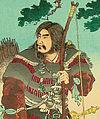
|
Hikohohodemi 彦火 |
Emperor Jimmu |
660–585 BC (75 years) |
721 or 711–585 BC (126 or 136 years) Son of kami Ugayafukiaezu. Claimed descent from the sun goddess, Amaterasu. Defeated Nagasunehiko in the Eastern Expedition to become emperor. Presumed legendary.[11] |
| 2 | 
|
Kamununakawamimi |
Emperor Suizei 綏靖 |
581–549 BC (32 years) |
632–549 BC (83 years) Son of Emperor Jimmu. Presumed legendary.[12] |
| 3 | 
|
Shikitsuhikotamatemi |
Emperor Annei |
549–511 BC (37 years) |
567–511 BC (56 years) Son of Emperor Suizei. Presumed legendary.[13] |
| 4 | 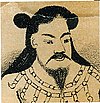
|
Ōyamatohikosukitomo |
Emperor Itoku 懿徳 |
510–477 BC (33 years) |
553–477 BC (76 years) Son of Emperor Annei. Presumed legendary.[14] |
| 5 | 
|
Mimatsuhikokaeshine |
Emperor Kōshō |
475–393 BC (82 years) |
506–393 BC (113 years) Son of Emperor Itoku. Presumed legendary.[15] |
| 6 | 
|
Yamatotarashihikokunioshihito |
Emperor Kōan |
392–291 BC (101 years) |
427–291 BC (136 years) Son of Emperor Kōshō. Presumed legendary.[16] |
| 7 | 
|
Ōyamatonekohikofutoni |
Emperor Kōrei |
290–215 BC (75 years) |
342–215 BC (127 years) Son of Emperor Kōan. Presumed legendary.[17] |
| 8 | 
|
Ōyamatonekohikokunikuru |
Emperor Kōgen |
214–158 BC (56 years) |
273–158 BC (115 years) Son of Emperor Kōrei. Presumed legendary.[18] |
| 9 | 
|
Wakayamato Nekohiko Ōbibi |
Emperor Kaika |
157–98 BC (59 years) |
208–98 BC (110 years) Son of Emperor Kōgen. Presumed legendary.[19] |
| 10 | 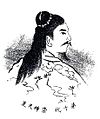
|
Mimaki |
Emperor Sujin |
97–30 BC (67 years) |
148–30 BC (118 years) Son of Emperor Kaika. First emperor with a direct possibility of existence.[20] Still presumed legendary.[21] |
| 11 | 
|
Ikume |
Emperor Suinin |
29 BC–AD 70 (99 years) |
69 BC–AD 70 (127 years) Son of Emperor Sujin. Presumed legendary.[22] |
| 12 | 
|
Ōtarashihiko |
Emperor Keikō |
71–130 (59 years) |
13 BC–AD 130 (143 years) Son of Emperor Suinin. Presumed legendary.[23] |
| 13 | 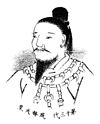
|
Wakatarashihiko |
Emperor Seimu |
131–190 (59 years) |
84–190 (106 years) Son of Emperor Keikō. Presumed legendary.[24] |
| 14 | 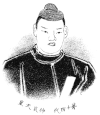
|
Tarashinakatsuhiko |
Emperor Chūai |
192–200 (8 years) |
149–200 (51 years) Grandson of Emperor Keikō; nephew of Emperor Seimu. First emperor to ascend the throne without being the son of the previous emperor. Died during a campaign against the Kumaso tribe. Presumed legendary.[25] |
| – | 
|
Okinagatarashi |
Empress Jingū |
201–269 (68 years) |
170–269 (99 years) Wife of Emperor Chūai; mother and regent of Emperor Ōjin. Not counted among the officially numbered emperors. Presumed legendary.[26] |
| 15 | 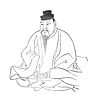
|
Homutawake |
Emperor Ōjin |
270–310 (40 years) |
201–310 (109 years) Son of Emperor Chūai and Empress Jingū. Deified in Shinto and Buddhism in Japan as Hachiman. Presumed legendary.[27] |
| 16 | 
|
Ohosazaki |
Emperor Nintoku |
313–399 (86 years) |
290–399 (108–109 years) Son of Emperor Ōjin. Presumed legendary.[28] |
| 17 | 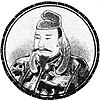
|
Ōenoizahowake |
Emperor Richū |
400–405 (5 years) |
336–405 (69 years) Son of Emperor Nintoku. Presumed legendary.[29] |
| 18 | 
|
Mizuhawake |
Emperor Hanzei |
406–410 (5 years) |
352–411 (59 years) Son of Emperor Nintoku; younger brother of Emperor Richū. Presumed legendary.[30] |
| 19 | 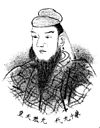
|
Oasatsuma Wakugo no Sukune |
Emperor Ingyō |
411–453 (42 years) |
376–453 (77 years) Son of Emperor Nintoku; younger brother of Emperor Richū and Emperor Hanzei. Presumed legendary.[31] |
| 20 | 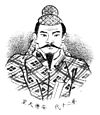
|
Anaho |
Emperor Ankō |
453–456 (3 years) |
401–456 (55 years) Son of Emperor Ingyō. Assassinated by Prince Mayowa. Presumed legendary.[32] |
| 21 | 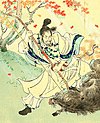
|
Ōhatuse no Wakatakeru |
Emperor Yūryaku |
456–479 (23 years) |
418–479 (61 years) Son of Emperor Ingyō; younger brother of Emperor Ankō. Presumed legendary.[33] |
| 22 | 
|
Shiraka |
Emperor Seinei |
480–484 (4 years) |
444–484 (40 years) Son of Emperor Yūryaku. Presumed legendary.[34] |
| 23 | 
|
Woke |
Emperor Kenzō |
485–487 (2 years) |
450–487 (37 years) Grandson of Emperor Richū; cousin and adopted son of Emperor Seinei. Presumed legendary.[35] |
| 24 | 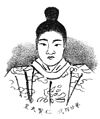
|
Oke |
Emperor Ninken |
488–498 (10 years) |
448–498 (50 years) Grandson of Emperor Richū; cousin and adopted son of Emperor Seinei; older brother of Emperor Kenzō. Presumed legendary.[36] |
| 25 | 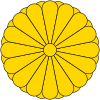
|
Ohatsuse no Wakasazaki |
Emperor Buretsu |
499–506 (7 years) |
489–506 (17 years) Son of Emperor Ninken. Presumed legendary.[37] |
| 26 | 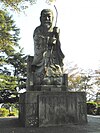
|
Ohodo[ii] 袁本 |
Emperor Keitai |
507–531 (24 years) |
450–531 (81 years) 5th-generation grandson of Emperor Ōjin. Became emperor at the recommendation of Ōtomo no Kanamura. Possible founder of a new dynasty. Presumed legendary.[38][39] |
| 27 | 
|
Magari 勾 |
Emperor Ankan |
534–535 (1 year) |
466–535 (69 years) Son of Emperor Keitai. Presumed legendary.[40] |
| 28 | 
|
Hinokuma-no-takata |
Emperor Senka |
536–539 (3 years) |
467–539 (72 years) Son of Emperor Keitai; younger brother of Emperor Ankan. Presumed legendary.[41] |
| 29 | 
|
Amekunioshiharakihironiwa |
Emperor Kinmei 欽明 |
540–571 (31 years) |
509–571 (62 years) Son of Emperor Keitai; younger brother of Emperor Ankan and Emperor Senka. First historically verifiable emperor.[5][42] |
| 30 | 
|
Nunakura no Futotamashiki 渟 |
Emperor Bidatsu |
572–585 (13 years) |
538–585 (47 years) Son of Emperor Kinmei.[43] |
| 31 | 
|
Tachibana no Toyohi |
Emperor Yōmei |
586–587 (1 year) |
517–587 (70 years) Son of Emperor Kinmei; half-brother of Emperor Bidatsu.[44] |
| 32 | 
|
Hatsusebe |
Emperor Sushun |
588–592 (4 years) |
522–592 (70 years) Son of Emperor Kinmei; half-brother of Emperor Bidatsu and Emperor Yōmei. Made emperor by Soga no Umako following the Soga–Mononobe conflict. Assassinated by Yamatonoaya no Koma on the orders of Soga no Umako.[45] |
| 33 | 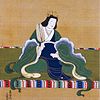
|
Nukatabe |
Empress Suiko |
593–628 (35 years) |
554–628 (74 years) Daughter of Emperor Kinmei; half-sister and wife of Emperor Bidatsu. First non-legendary female monarch. Prince Shōtoku acted as her regent.[46] |
| 34 | 
|
Tamura |
Emperor Jomei 舒明 |
629–641 (12 years) |
593–641 (48 years) Grandson of Emperor Bidatsu; great nephew of Empress Suiko.[47] |
| 35 | 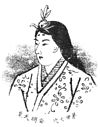
|
Takara |
Empress Kōgyoku |
642–645 (3 years) |
594–661 (67 years) Great-granddaughter of Emperor Bidatsu; wife of Emperor Jomei. First reign. Abdicated as a result of the Isshi incident.[48] |
| 36 | 
|
Karu |
Emperor Kōtoku |
645–654 (9 years) Taika, Hakuchi |
597–654 (57 years) Great-grandson of Emperor Bidatsu; younger brother of Empress Kōgyoku. First era name assigned.[49] |
| 37 | 
|
Takara |
Empress Saimei |
655–661 (6 years) |
594–661 (67 years) Older sister of Emperor Kōtoku. Previously reigned as Empress Kōgyoku. Second reign.[50] |
| 38 | 
|
Kazuraki |
Emperor Tenji |
662–672 (10 years) |
626–672 (46 years) Son of Emperor Jomei and Empress Kōgyoku.[51] |
| 39 | 
|
Ōtomo[iii] |
Emperor Kōbun |
672 (8 months) |
648–672 (24 years) Son of Emperor Tenji. Deposed and committed suicide during the Jinshin War. Not recognized as emperor until 1870.[52] |
| 40 | 
|
Ōama |
Emperor Tenmu |
673–686 (14 years) Shuchō |
622–686 (56 years) Son of Emperor Jomei and Empress Kōgyoku; younger brother of Emperor Tenji. Deposed his nephew, Emperor Kōbun, during the Jinshin War.[53] |
| 41 | 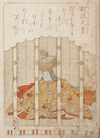
|
Unonosarara[iv] 鸕野 |
Empress Jitō |
687–697 (10 years)[v] |
646–703 (57 years) Daughter of Emperor Tenji; niece and wife of Emperor Tenmu. Abdicated.[55] |
| 42 | 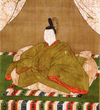
|
Karu[vi] 珂瑠 |
Emperor Monmu |
697–707 (10 years) Taihō, Keiun |
683–707 (24 years) Grandson of Emperor Tenmu and Empress Jitō.[56] |
| 43 | 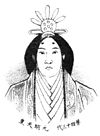
|
Ahe[vii] |
Empress Genmei |
707–715 (8 years) Keiun, Wadō |
660–721 (61 years) Daughter of Emperor Tenji; half-sister of Empress Jitō; mother of Emperor Monmu. Abdicated.[57] |
| 44 | 
|
Hidaka[viii] |
Empress Genshō |
715–724 (9 years) Reiki, Yōrō |
681–748 (67 years) Daughter of Empress Genmei; elder sister of Emperor Monmu. Only instance of an empress regnant inheriting the throne from another empress regnant. Abdicated.[58] |
| 45 | 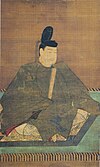
|
Obito |
Emperor Shōmu |
724–749 (25 years) Jinki, Tenpyō, Tenpyō-kanpō |
699–756 (57 years) Son of Emperor Monmu; nephew of Empress Genshō. Abdicated.[59] |
| 46 | 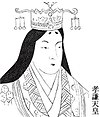
|
Abe |
Empress Kōken |
749–758 (9 years) Tenpyō-kanpō, Tenpyō-shōhō, Tenpyō-hōji |
718–770 (52 years) Daughter of Emperor Shōmu. First reign. Abdicated.[60] |
| 47 | 
|
Ōi |
Emperor Junnin |
758–764 (6 years) Tenpyō-hōji |
733–765 (32 years) Grandson of Emperor Tenmu; cousin of Empress Kōken. Deposed. Posthumously named emperor in 1870.[61] |
| 48 | 
|
Abe |
Empress Shōtoku |
764–770 (6 years) Tenpyō-hōji, Tenpyō-jingo, Jingo-keiun |
718–770 (52 years) Deposed her cousin, Emperor Junnin. Previously reigned as Empress Kōken. Second reign.[62] |
| 49 | 
|
Shirakabe |
Emperor Kōnin |
770–781 (11 years) Hōki, Ten'ō |
708–782 (73 years) Grandson of Emperor Tenji; brother-in-law of Empress Shōtoku. Abdicated.[63] |
| 50 | 
|
Yamabe |
Emperor Kanmu |
781–806 (25 years) Ten'ō, Enryaku |
736–806 (70 years) Son of Emperor Kōnin.[64] |
| 51 | 
|
Ate |
Emperor Heizei |
806–809 (3 years) Daidō |
773–824 (51 years) Son of Emperor Kanmu. Abdicated.[65] |
| 52 | 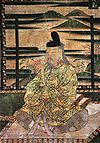
|
Kamino |
Emperor Saga |
809–823 (14 years) Daidō, Kōnin |
785–842 (57 years) Son of Emperor Kanmu; younger brother of Emperor Heizei. Abdicated.[66] |
| 53 | 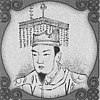
|
Ōtomo |
Emperor Junna |
823–833 (10 years) Kōnin, Tenchō |
786–840 (54 years) Son of Emperor Kanmu; younger brother of Emperor Heizei and Emperor Saga. Abdicated.[67] |
| 54 | 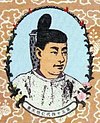
|
Masara |
Emperor Ninmyō |
833–850 (17 years) Tenchō, Jōwa, Kashō |
808–850 (41 years) Son of Emperor Saga; nephew and adopted son of Emperor Junna.[68] |
| 55 | 
|
Michiyasu |
Emperor Montoku |
850–858 (8 years) Kashō, Ninju, Saikō, Ten'an |
827–858 (31 years) Son of Emperor Ninmyō.[69] |
| 56 | 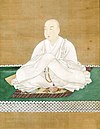
|
Korehito |
Emperor Seiwa |
858–876 (18 years) Ten'an, Jōgan |
850–881 (30 years) Son of Empereor Montoku. Abdicated.[70] |
| 57 | 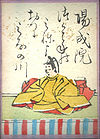
|
Sadaakira |
Emperor Yōzei |
876–884 (8 years) Jōgan, Gangyō |
869–949 (80 years) Son of Emperor Seiwa. Deposed by Fujiwara no Mototsune.[71] |
| 58 | 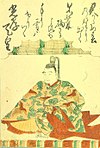
|
Tokiyasu |
Emperor Kōkō |
884–887 (3 years) Gangyō, Ninna |
830–887 (57 years) Son of Emperor Ninmyō; great uncle of Emperor Yōzei. Became emperor at the recommendation of Fujiwara no Mototsune.[72] |
| 59 | 
|
Sadami |
Emperor Uda |
887–897 (10 years) Ninna, Kanpyō |
866–931 (65 years) Son of Emperor Kōkō. Abdicated.[73] |
| 60 | 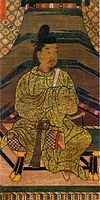
|
Atsuhito[ix] |
Emperor Daigo |
897–930 (33 years) Kanpyō, Shōtai, Engi, Enchō |
884–930 (46 years) Son of Emperor Uda. Abdicated.[74] |
| 61 | 
|
Yutaakira[x] |
Emperor Suzaku |
930–946 (16 years) Enchō, Jōhei, Tengyō |
921–952 (30 years) Son of Emperor Daigo. Abdicated.[75] |
| 62 | 
|
Nariakira |
Emperor Murakami |
946–967 (21 years) Tengyō, Tenryaku, Tentoku, Ōwa, Kōhō |
924–967 (42 years) Son of Emperor Daigo; younger brother of Emperor Suzaku.[76] |
| 63 | 
|
Norihara |
Emperor Reizei |
967–969 (2 years) Kōhō, Anna |
949–1011 (62 years) Son of Emperor Murakami. Abdicated.[77] |
| 64 | 
|
Morihira |
Emperor En'yū |
969–984 (15 years) Anna, Tenroku, Ten'en, Jōgen, Tengen, Eikan |
958–991 (32 years) Son of Emperor Murakami; younger brother of Emperor Reizei. Abdicated.[78] |
| 65 | 
|
Morosada |
Emperor Kazan |
984–986 (2 years) Eikan, Kanna |
968–1008 (39 years) Son of Emperor Reizei; nephew of Emperor En'yū. Abdicated.[79] |
| 66 | 
|
Kanehito |
Emperor Ichijō |
986–1011 (25 years) Kanna, Eien, Eiso, Shōryaku, Chōtoku, Chōhō, Kankō |
980–1011 (31 years) Son of Emperor Emperor En'yū. Abdicated.[80] |
| 67 | 
|
Okisada[xi] |
Emperor Sanjō |
1011–1016 (5 years) Kankō, Chōwa |
975–1017 (42 years) Son of Emperor Reizei; half-brother of Emperor Kazan; cousin of Emperor Ichijō. Abdicated.[81] |
| 68 | 
|
Atsuhira[xii] |
Emperor Go-Ichijō |
1016–1036 (20 years) Chōwa, Kannin, Jian, Manju, Chōgen |
1008–1036 (27 years) Son of Emperor Ichijō; cousin of Emperor Sanjō.[82] |
| 69 | 
|
Atsunaga |
Emperor Go-Suzaku |
1036–1045 (9 years) Chōgen, Chōryaku, Chōkyū, Kantoku |
1009–1045 (37 years) Son of Emperor Ichijō; younger brother of Emperor Go-Ichijō. Abdicated.[83] |
| 70 | 
|
Chikahito |
Emperor Go-Reizei |
1045–1068 (23 years) Kantoku, Eishō, Tengi, Kōhei, Jiryaku |
1025–1068 (42 years) Son of Emperor Go-Suzaku.[84] |
| 71 | 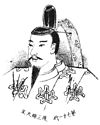
|
Takahito |
Emperor Go-Sanjō |
1068–1073 (5 years) Jiryaku, Enkyū |
1032–1073 (40 years) Son of Emperor Go-Suzaku; half-brother of Emperor Go-Reizei. Abdicated.[85] |
| 72 | 
|
Sadahito |
Emperor Shirakawa |
1073–1087 (14 years) Enkyū, Jōhō, Jōryaku, Eihō, Ōtoku |
1053–1129 (76 years) Son of Emperor Go-Sanjō. Abdicated.[86] |
| 73 | 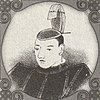
|
Taruhito[xiii] |
Emperor Horikawa |
1087–1107 (20 years) Kanji, Kahō, Eichō, Jōtoku, Kōwa, Chōji, Kajō |
1079–1107 (28 years) Son of Emperor Shirakawa.[87] |
| 74 | 
|
Munehito |
Emperor Toba |
1107–1123 (16 years) Kajō, Tennin, Ten'ei, Eikyū, Gen'ei, Hōan |
1103–1156 (53 years) Son of Emperor Horikawa. Forced to abdicate by Emperor Shirakawa.[88] |
| 75 | 
|
Akihito |
Emperor Sutoku |
1123–1142 (19 years) Hōan, Tenji, Daiji, Tenshō, Chōshō, Hōen, Eiji |
1119–1164 (45 years) Son of Emperor Toba. Abdicated. Attempted to depose Emperor Go-Shirakawa during the Hōgen rebellion.[89] |
| 76 | 
|
Narihito |
Emperor Konoe |
1142–1155 (13 years) Eiji, Kōji, Ten'yō, Kyūan, Ninpei, Kyūju |
1139–1155 (16 years) Son of Emperor Toba; half-brother of Emperor Sutoku.[90] |
| 77 | 
|
Masahito |
Emperor Go-Shirakawa |
1155–1158 (3 years) Kyūju, Hōgen |
1127–1192 (64 years) Son of Emperor Toba; younger brother of Emperor Sutoku; half-brother of Emperor Konoe. Abdicated.[91] |
| 78 | 
|
Morihito |
Emperor Nijō |
1158–1165 (7 years) Hōgen, Heiji, Eiryaku, Ōhō, Chōkan |
1143–1165 (22 years) Son of Emperor Go-Shirakawa. Abdicated.[92] |
| 79 | 
|
Nobuhito[xiv] |
Emperor Rokujō |
1165–1168 (3 years) Chōkan, Eiman, Nin'an |
1164–1176 (11 years) Son of Emperor Nijō. Deposed by Emperor Go-Shirakawa.[93] |
| 80 | 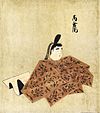
|
Norihito[xv] |
Emperor Takakura |
1168–1180 (12 years) Nin'an, Kaō, Jōan, Angen, Jishō |
1161–1181 (19 years) Son of Emperor Go-Shirakawa; half-brother of Emperor Nijō; uncle of Emperor Rokujō. Forced to abdicate by Taira no Kiyomori.[94] |
| 81 | 
|
Tokihito[xvi] |
Emperor Antoku |
1180–1185 (5 years) Jishō, Yōwa, Juei, Genryaku |
1178–1185 (6 years) Son of Emperor Takakura. Died at the Battle of Dan-no-ura during the Genpei War.[95] |
| 82 | 
|
Takahira[xvii] |
Emperor Go-Toba |
1183–1198 (15 years) Juei, Genryaku, Bunji, Kenkyū |
1180–1239 (58 years) Son of Emperor Takakura; half-brother of Emperor Antoku. Made emperor by Emperor Go-Shirakawa during the Genpei War. Kamakura shogunate turned the emperor into a figurehead. Abdicated. Attempted to overthrow the Kamakura shogunate during the Jōkyū War.[96] |
| 83 | 
|
Tamehito |
Emperor Tsuchimikado |
1198–1210 (12 years) Kenkyū, Shōji, Kennin, Genkyū, Ken'ei, Jōgen |
1196–1231 (35 years) Son of Emperor Go-Toba. Persuaded by Emperor Go-Toba to abdicate. Exiled following the Jōkyū War.[97] |
| 84 | 
|
Morinari |
Emperor Juntoku |
1210–1221 (11 years) Jōgen, Kenryaku, Kempo, Jōkyū |
1197–1242 (44 years) Son of Emperor Go-Toba; half-brother of Emperor Tsuchimikado. Forced to abdicate following the Jōkyū War.[98] |
| 85 | 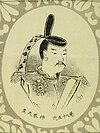
|
Kanenari |
Emperor Chūkyō |
1221 (2 months) Jōkyū |
1218–1234 (15 years) Son of Emperor Juntoku. Deposed and exiled following the Jōkyū War. Posthumously named emperor in 1870.[99] |
| 86 | 
|
Yutahito[xviii] |
Emperor Go-Horikawa |
1221–1232 (11 years) Jōkyū, Jōō, Gennin, Karoku, Antei, Kangi, Jōei |
1212–1234 (22 years) Grandson of Emperor Takakura; first cousin of Emperor Chūkyō. Abdicated.[100] |
| 87 | 
|
Mitsuhito[xix] |
Emperor Shijō |
1232–1242 (10 years) Jōei, Tenpuku, Bunryaku, Katei, Ryakunin, En'ō, Ninji |
1231–1242 (10 years) Son of Emperor Go-Horikawa.[101] |
| 88 | 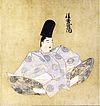
|
Kunihito |
Emperor Go-Saga |
1242–1246 (4 years) Ninji, Kangen |
1220–1272 (51 years) Son of Emperor Tsuchimikado; second cousin of Emperor Shijō. Abdicated.[102] |
| 89 | 
|
Hisahito |
Emperor Go-Fukakusa |
1246–1260 (14 years) Kangen, Hōji, Kenchō, Kōgen, Shōka, Shōgen |
1243–1304 (61 years) Son of Emperor Go-Saga. From the Jimyōin line. Abdicated at the insistence of Emperor Go-Saga.[103] |
| 90 | 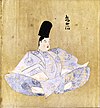
|
Tsunehito |
Emperor Kameyama |
1260–1274 (14 years) Shōgen, Bun'ō, Kōchō, Bun'ei |
1249–1305 (56 years) Son of Emperor Go-Saga; younger brother of Emperor Go-Fukakusa. From the Daikakuji line. Abdicated.[104] |
| 91 | 
|
Yohito |
Emperor Go-Uda |
1274–1287 (13 years) Bun'ei, Kenji, Kōan |
1267–1324 (56 years) Son of Emperor Kameyama. From the Daikakuji line. Forced to abdicate by Emperor Go-Fukakusa.[105] |
| 92 | 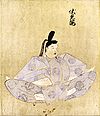
|
Hirohito 熈仁 |
Emperor Fushimi |
1287–1298 (11 years) Kōan, Shōō, Einin |
1265–1317 (52 years) Son of Emperor Go-Fukakusa. From the Jimyōin line. Abdicated.[106] |
| 93 | 
|
Tanehito |
Emperor Go-Fushimi |
1298–1301 (3 years) Einin, Shōan |
1288–1336 (48 years) Son of Emperor Fushimi. From the Jimyōin line. Forced to abdicate by the Daikakuji line. Traditional dates used.[107] |
| 94 | 
|
Kuniharu |
Emperor Go-Nijō |
1301–1308 (7 years) Shōan, Kengen, Kagen, Tokuji |
1285–1308 (23 years) Son of Emperor Go-Uda. From the Daikakuji line.[108] |
| 95 | 
|
Tomihito |
Emperor Hanazono |
1308–1318 (10 years) Enkyō, Ōchō, Shōwa, Bunpō |
1297–1348 (51 years) Son of Emperor Fushimi. From the Jimyōin line. Agreed to alternate control of the throne between the Daikakuji and Jimyōin lines.[109] |
| 96 | 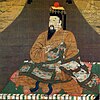
|
Takaharu |
Emperor Go-Daigo |
1318–1339 (21 years) Bunpō, Gen'ō, Genkō (1321–24), Shōchū, Karyaku, Gentoku, Genkō (1331–34), Kenmu, Engen |
1288–1339 (50 years) Son of Emperor Go-Uda; younger brother of Emperor Go-Nijō. From the Daikakuji line. Kamakura shogunate ended in the Genkō War. Brief imperial rule during the Kenmu Restoration. Opposed the Ashikaga shogunate. Became the first emperor of the Southern Court.[110] |
| 97 | 
|
Noriyoshi[xx] |
Emperor Go-Murakami |
1339–1368 (29 years) Engen, Kōkoku, Shōhei |
1328–1368 (40 years) Son of Emperor Go-Daigo. Second emperor of the Southern Court. Southern Court briefly took the Northern Court's capital, Kyoto, during the Kannō disturbance.[111] |
| 98 | 
|
Yutanari |
Emperor Chōkei |
1368–1383 (15 years) Shōhei, Kentoku, Bunchū, Tenju, Kōwa |
1343–1394 (51 years) Son of Emperor Go-Murakami. Third emperor of the Southern Court. Abdicated.[112] |
| 99 | 
|
Hironari 熙成 |
Emperor Go-Kameyama |
1383–1392 (9 years) Kōwa, Genchū |
c. 1347–1424 (c. 77 years) Son of Emperor Go-Murakami; younger brother of Emperor Chōkei. Fourth and last emperor of the Southern Court. Agreed to peace with the Northern Court. Abdicated in favor of the Northern Court line.[113] |
| (1) | 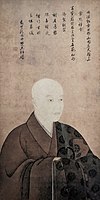
|
Kazuhito |
Emperor Kōgon |
1331–1333 (2 years) Gentoku, Shōkyō |
1313–1364 (51 years) Son of Emperor Go-Fushimi; nephew and adopted son of Emperor Hanazono. From the Jimyōin line. Made the first emperor of the Northern Court by the Kamakura shogunate during the Genkō War. Deposed by Emperor Go-Daigo of the Daikakuji line. Captured by the Southern Court during the Kannō disturbance.[114] |
| (2) | 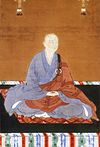
|
Yutahito |
Emperor Kōmyō |
1336–1348 (12 years) Kenmu, Ryakuō, Kōei, Jōwa |
1322–1380 (58 years) Son of Emperor Go-Fushimi; younger brother of Emperor Kōgon. Made second emperor of the Northern Court by the Ashikaga shogunate. Abdicated. Captured by the Southern Court during the Kannō disturbance.[115] |
| (3) | 
|
Okihito[xxi] |
Emperor Sukō |
1348–1351 (3 years) Jōwa, Kannō |
1334–1398 (64 years) Son of Emperor Kōgon; nephew of Emperor Kōmyō. Third emperor of the Northern Court. Abdicated. Captured by the Southern Court during the Kannō disturbance.[116] |
| (4) | 
|
Iyahito |
Emperor Go-Kōgon |
1352–1371 (19 years) Bunna, Kōan, Jōji, Ōan |
1338–1374 (36 years) Son of Emperor Kōgon; younger brother of Emperor Sukō. Became the fourth Emperor of the Northern Court after the Kannō disturbance. Abdicated.[117] |
| (5) | 
|
Ohito |
Emperor Go-En'yū |
1371–1382 (11 years) Ōan, Eiwa, Kōryaku, Eitoku |
1359–1393 (34 years) Son of Emperor Go-Kōgon. Fifth emperor of the Northern Court. Abdicated in favor of Emperor Go-Komatsu.[118] |
| (6) | 
|
Motohito |
Emperor Go-Komatsu[xxii] |
1382–1392 (10 years) Eitoku, Shitoku, Kakei, Kōō, Meitoku |
1377–1433 (56 years) Son of Emperor Go-En'yū. Sixth and last emperor of the Northern Court from 1382 until 1392. Became the legitimate emperor following Emperor Go-Kameyama's abdication. Agreed to alternate control of the throne by the Northern Court and the Southern Court. All emperors after him are from the Northern line.[119][120] |
| 100 | 1392–1412 (20 years) Meitoku, Ōei | ||||
| 101 | 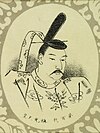
|
Mihito[xxiii] |
Emperor Shōkō |
1412–1428 (16 years) Ōei, Shōchō |
1401–1428 (27 years) Son of Emperor Go-Komatsu.[121] |
| 102 | 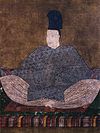
|
Hikohito 彦仁 |
Emperor Go-Hanazono |
1428–1464 (36 years) Shōchō, Eikyō, Kakitsu, Bun'an, Hōtoku, Kyōtoku, Kōshō, Chōroku, Kanshō |
1419–1471 (51 years) Great-grandson of Northern Emperor Sukō; third cousin of Emperor Shōkō. Abdicated. Traditional dates used.[122] |
| 103 | 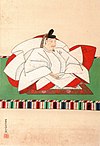
|
Fusahito |
Emperor Go-Tsuchimikado |
1464–1500 (36 years) Kanshō, Bunshō, Ōnin, Bunmei, Chōkyō, Entoku, Meiō |
1442–1500 (58 years) Son of Emperor Go-Hanazono. Ōnin War led to the start of the Sengoku period.[123] |
| 104 | 
|
Katsuhito |
Emperor Go-Kashiwabara[xxiv] |
1500–1526 (26 years) Meiō, Bunki, Daiei |
1462–1526 (64 years) Son of Emperor Go-Tsuchimikado. Imperial rule in the Ashikaga shogunate reached its lowest point in his reign.[124] |
| 105 | 
|
Tomohito |
Emperor Go-Nara[xxv] |
1526–1557 (31 years) Daiei, Kyōroku, Tenbun, Kōji |
1495–1557 (62 years) Son of Emperor Go-Kashiwabara.[125] |
| 106 | 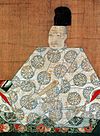
|
Michihito |
Emperor Ōgimachi |
1557–1586 (29 years) Kōji, Eiroku, Genki, Tenshō |
1517–1593 (76 years) Son of Emperor Go-Nara. Ashikaga shogunate overthrown by Oda Nobunaga. Abdicated.[126] |
| 107 | 
|
Katahito[xxvi] |
Emperor Go-Yōzei |
1586–1611 (25 years) Tenshō, Bunroku, Keichō |
1571–1617 (46 years) Grandson of Emperor Ōgimachi. Tokugawa shogunate established. Sengoku period ended.[127] |
| 108 | 
|
Kotohito[xxvii] |
Emperor Go-Mizunoo[xxviii] |
1611–1629 (18 years) Keichō, Genna, Kan'ei |
1596–1680 (84 years) Son of Emperor Go-Yōzei. Japan implements isolationist policy. Purple Robe Incident led to his abdication.[128] |
| 109 | 
|
Okiko |
Empress Meishō |
1629–1643 (14 years) Kan'ei |
1624–1696 (72 years) Daughter of Emperor Go-Mizunoo. Abdicated.[129] |
| 110 | 
|
Tsuguhito 紹仁 |
Emperor Go-Kōmyō |
1643–1654 (11 years) Kan'ei, Shōhō, Keian, Jōō |
1633–1654 (21 years) Son of Emperor Go-Mizunoo; younger brother of Empress Meishō.[130] |
| 111 | 
|
Nagahito[xxix] |
Emperor Go-Sai[xxx] |
1655–1663 (8 years) Jōō, Meireki, Manji, Kanbun |
1638–1685 (47 years) Son of Emperor Go-Mizunoo; younger half-brother of Empress Meishō and Emperor Go-Kōmyō. Abdicated.[131] |
| 112 | 
|
Satohito 識仁 |
Emperor Reigen |
1663–1687 (24 years) Kanbun, Enpō, Tenna, Jōkyō |
1654–1732 (78 years) Son of Emperor Go-Sai. Abdicated.[132] |
| 113 | 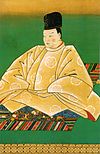
|
Asahito[xxxi] |
Emperor Higashiyama |
1687–1709 (22 years) Jōkyō, Genroku, Hōei |
1675–1710 (34 years) Son of Emperor Reigen. Abdicated.[133] |
| 114 | 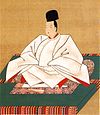
|
Yasuhito[xxxii] |
Emperor Nakamikado |
1709–1735 (26 years) Hōei, Shōtoku, Kyōhō |
1702–1737 (35 years) Son of Emperor Higashiyama. Abdicated.[134] |
| 115 | 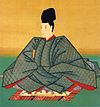
|
Teruhito |
Emperor Sakuramachi |
1735–1747 (12 years) Kyōhō, Genbun, Kanpō, Enkyō |
1720–1750 (30 years) Son of Emperor Nakamikado. Abdicated.[135] |
| 116 | 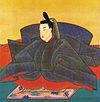
|
Tōhito 遐仁 |
Emperor Momozono |
1747–1762 (15 years) Enkyō, Kan'en, Hōreki |
1741–1762 (20 years) Son of Emperor Sakuramachi. Abdicated.[136] |
| 117 | 
|
Toshiko |
Empress Go-Sakuramachi |
1762–1771 (9 years) Hōreki, Meiwa |
1740–1813 (73 years) Daughter of Emperor Sakuramachi; younger sister of Emperor Momozono.[137] |
| 118 | 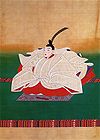
|
Hidehito |
Emperor Go-Momozono |
1771–1779 (8 years) Meiwa, An'ei |
1758–1779 (21 years) Son of Emperor Momozono; nephew of Empress Go-Sakuramachi.[138] |
| 119 | 
|
Morohito |
Emperor Kōkaku |
1780–1817 (37 years) An'ei, Tenmei, Kansei, Kyōwa, Bunka |
1771–1840 (69 years) Great-grandson of Emperor Higashiyama; cousin and adopted son of Emperor Go-Momozono. Abdicated.[139] |
| 120 | 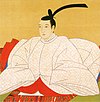
|
Ayahito |
Emperor Ninkō |
1817–1846 (29 years) Bunka, Bunsei, Tenpō, Kōka |
1800–1846 (46 years) Son of Emperor Kōkaku.[140] |
| 121 | 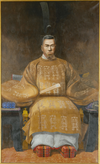
|
Osahito |
Emperor Kōmei |
1846–1867 (21 years) Kōka, Kaei, Ansei, Man'en, Bunkyū, Genji, Keiō |
1831–1867 (35 years) Son of Emperor Ninkō. Reigned during the Bakumatsu period during which Japan ended its isolationist policy and changed from Tokugawa rule to Imperial rule. Last instance of an emperor with multiple era names.[141] |
| 122 | 
|
Mutsuhito |
Emperor Meiji |
3 February 1867 – 30 July 1912 (45 years, 178 days) Keiō, Meiji |
3 November 1852 – 30 July 1912 (Aged 59) Son of Emperor Kōmei. Ended the Tokugawa Shogunate with the Meiji Restoration (3 January 1868). First emperor of the Empire of Japan.[142][143] |
| 123 | 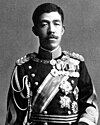
|
Yoshihito |
Emperor Taishō |
30 July 1912 – 25 December 1926 (14 years, 148 days) Taishō |
31 August 1879 – 25 December 1926 (Aged 47) Son of Emperor Meiji. Taishō Democracy shifted political power from the genrō to the Imperial Diet and political parties. His eldest son, Crown Prince Hirohito, served as Sesshō ( |
| 124 | 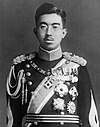
|
Hirohito |
Emperor Shōwa |
25 December 1926 – 7 January 1989 (62 years, 13 days) Shōwa |
29 April 1901 – 7 January 1989 (Aged 87) Son of Emperor Taishō. Served as Sesshō from 1921 to 1926. Last emperor of the Empire of Japan. Reign saw World War II and post-war economic miracle. Longest reigning verifiable emperor in Japanese history.[143][145] |
| 125 | 
|
Akihito |
(Living) | 7 January 1989 – 30 April 2019 (30 years, 113 days) Heisei |
born 23 December 1933 (Age 90) Son of Emperor Shōwa. Abdicated and later referred to as Jōkō ( |
| 126 | 
|
Naruhito |
(Living) | 1 May 2019 – present (5 years, 141 days) Reiwa |
born 23 February 1960 (Age 64) Son of Akihito. Referred to as Kinjō Tennō ( |
Posthumously recognized individuals
[edit]This is a list of individuals who did not reign as emperor during their lifetime but were later recognized as Japanese emperors posthumously.
| Portrait | Personal name | Posthumous name | Year recognized | Life details |
|---|---|---|---|---|

|
Prince Kusakabe |
Emperor Oka |
759 | 662–689 (27 years) Son of Emperor Tenmu; husband of Empress Genmei; father of Emperor Monmu and Empress Genshō. Made crown prince in 681; heir to Emperor Tenmu. Died prior to acceding the throne following Emperor Tenmu's death.[149][150] |
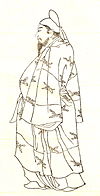
|
Prince Toneri |
Emperor Sudōjinkei |
759 | 676–735 (59 years) Son of Emperor Tenmu; half-brother of Prince Kusakabe; father of Emperor Junnin.[151][152] |

|
Prince Shiki |
Emperor Kasuga |
770 | died 716
Son of Emperor Tenji; half-brother of Emperor Tenmu, Empress Jitō, Empress Genmei and Emperor Kōbun; father of Emperor Kōnin; half-uncle of Prince Kusakabe and Prince Toneri.[153][154] |

|
Prince Sawara |
Emperor Sudō |
800 | 750–785 (35 years) Son of Emperor Kōnin; younger brother of Emperor Kanmu. Made crown prince in 781. Implicated in the assassination of Fujiwara no Tanetsugu. Died on the way to exile.[153][155] |

|
Prince Masahito |
Cloistered Emperor Yōkō |
Unknown | 1552–1586 (34 years) Son of Emperor Emperor Ōgimachi; father of Emperor Go-Yōzei. Posthumously recognized as emperor by Emperor Go-Yōzei.[153][156] |

|
Sukehito, Prince Kan'in 閑院 |
Emperor Kyōkō |
1884 | 1733–1794 (61 years) Grandson of Emperor Higashiyama; father of Emperor Kōkaku.[157][158] |
See also
[edit]- Emperor of Japan
- Empress of Japan
- Sesshō and Kampaku
- Shogun
- Prime Minister of Japan
- Family tree of Japanese monarchs
- Princess Iitoyo
References
[edit]Notes
[edit]- ^ Early dates vary depending on the author. These are calculated from the reign-lengths given by the Nihon Shoki (Kojiki when lacking information). Jimmu is said to have died in the 76th year of his reign, i.e. he ruled 75 years. He was 127 years old according to East Asian age reckoning, i.e. 126 in Western reckoning.[10] Regnal years are counted using inclusive reckoning until Empress Jitō, the last reign covered by the Nihon Shoki.
- ^ Also called as Hikofuto (彦太).
- ^ Also known as Iga (
伊賀 ). - ^ Also known as Unonosasara or Uno.
- ^ Her dates are usually given as 686–697. However, the Nihon Shoki states that she died on her 11th year, i.e. she ruled 10 years.[54]
- ^ Name also written as
軽 . - ^ Name also written as
阿部 . - ^ Name also written as
日 高 . - ^ Previously named Minamoto no Korezane (
源 維城). - ^ Also known as Hiroakira.
- ^ Also known as Iyasada or Sukesada.
- ^ Also known as Atsunari.
- ^ Also known as Yoshihito.
- ^ Also known as Yoshihito or Toshihito.
- ^ Also known as Nobuhito.
- ^ Also known as Kotohito.
- ^ Also known as Takanari.
- ^ Also known as Motsihito.
- ^ Also known as Tosihito.
- ^ Also known as Norinaga.
- ^ Previously named Masuhito (
益 仁 ). - ^ Also known as Emperor Go-Kōkō.
- ^ Initially written as 躬仁.
- ^ Also known as Emperor Go-Kanmu.
- ^ Also known as Emperor Go-Heizei.
- ^ Also known as Kazuhito (
和 仁 ). - ^ Also known as Masahito.
- ^ Also known as Emperor Go-Minoo or Emperor Go-Seiwa.
- ^ Also known as Yoshihito.
- ^ Also known as Emperor Go-Saiin or Emperor Go-Junna.
- ^ Also known as Tomohito.
- ^ Also known as Yoshihito.
Citations
[edit]- ^ Smits, Gregory J. (1991). Political Thought in Japanese Historical Writing: From Kojiki (712) to Tokushi Yoron (1712). Wilfrid Laurier University Press. pp. 30–32. ISBN 9780889209978.
- ^ a b Vogel, Ezra F. (2019). China and Japan: Facing History. Harvard University Press. pp. 15–17. ISBN 9780674240766.
- ^ Mason, Richard (2011). "Chapter Two". History of Japan: Revised Edition. Tuttle Publishing. ISBN 9781462900978.
- ^ Ibaraki, Yoshiyuki (2013). "A Review of the Inscription of the Iron Sword Discovered at Inariyama Old Tomb of the Sakitama Old Tombs' Group".
皇 学 館 論叢 . 46 (5). KOGAKKAN RONSO: 1–35. - ^ a b Hoye, Timothy (1999). Japanese Politics: Fixed and Floating Worlds. Prentice Hall. p. 78. ISBN 9780132712897.
- ^ Holcombe, Charles (January 2001). The Genesis of East Asia: 221 B.C. – A.D. 907. University of Hawaii Press. p. 198. ISBN 978-0-8248-2465-5.
- ^ Nussbaum, "Nengō", p. 704.
- ^ Imperial Household Agency.
- ^ Nussbaum, "Traditional Order of Tennō", p. 962.
- ^ Titsingh, pp. 1–3; Aston, 1, pp.109–137; Brown, p. 249; Varley, pp. 84–88; Nussbaum, p. 420.
- ^ Titsingh, pp. 1–3; Aston, 1, pp.109–137; Brown, p. 249; Varley, pp. 84–88; Nussbaum, p. 420.
- ^ Titsingh, pp. 3–4; Aston, 1, pp.138–141; Brown, pp. 250–251; Varley, pp. 88–89.
- ^ Titsingh, p. 4; Aston, 1, pp.141–142; Brown, p. 251; Varley, p. 89; Nussbaum, p. 32.
- ^ Titsingh, p. 4; Aston, 1, pp.142–143; Brown, p. 251; Varley, p. 89; Nussbaum, p. 405.
- ^ Titsingh, pp. 4–5; Aston, 1, pp.144–145; Brown, p. 251; Varley, p. 90; Nussbaum, p. 564.
- ^ Titsingh, p. 5; Aston, 1, pp.145–146; Brown, p. 251; Varley, p. 90; Nussbaum, p. 536.
- ^ Titsingh, pp. 5–6; Aston, 1, pp.146–147; Brown, p. 252; Varley, pp. 90–92; Nussbaum, p. 561.
- ^ Titsingh, p. 6; Aston, 1, pp.147–148; Brown, p. 252; Varley, pp. 92–93; Nussbaum, p. 542.
- ^ Titsingh, pp. 6–7; Aston, 1, pp.148–149; Brown, p. 252; Varley, p. 93; Nussbaum, p. 451.
- ^ Henshall, Kenneth (2013). Historical Dictionary of Japan to 1945. Scarecrow Press. ISBN 978-0-8108-7872-3.
- ^ Titsingh, pp. 7–9; Aston, 1, pp.150–164; Brown, p. 252; Varley, pp. 93–95; Nussbaum, p. 910.
- ^ Titsingh, pp. 9–10; Aston, 1, pp.165–187; Brown, pp. 252–254; Varley, pp. 95–96; Nussbaum, p. 910.
- ^ Titsingh, pp. 11–14; Aston, 1, pp.188–214; Brown, p. 254; Varley, pp. 96–99; Nussbaum, p. 505.
- ^ Titsingh, pp. 14–15; Aston, 1, pp.214–216; Brown, p. 254; Varley, pp. 99–100; Nussbaum, p. 836.
- ^ Titsingh, p. 15; Aston, 1, pp.217–223; Brown, pp. 254–255; Varley, pp. 100–101; Nussbaum, p. 125.
- ^ Titsingh, pp. 16–19; Aston, 1, pp.224–253; Brown, p. 255; Varley, pp. 101–103.
- ^ Titsingh, pp. 19–22; Aston, 1, pp.254–271; Brown, p. 255–256; Varley, pp. 103–110].
- ^ Titsingh, pp. 22–24; Aston, 1, pp.272–300; Brown, p. 256–257; Varley, pp. 110–111; Nussbaum, p. 716.
- ^ Titsingh, pp. 24–25; Aston, 1, pp.301–310; Brown, p. 257; Varley, p. 111.
- ^ Titsingh, p. 25; Aston, 1, pp.310–311; Brown, p. 257; Varley, p. 112; Nussbaum, p. 288.
- ^ Titsingh, p. 26; Aston, 1, pp.312–328; Brown, p. 257–258; Varley, p. 112.
- ^ Titsingh, p. 26; Aston, 1, pp.328–332; Brown, p. 258; Varley, p. 113; Nussbaum, p. 32.
- ^ Titsingh, pp. 27–28; Aston, 1, pp.333–372; Brown, p. 258; Varley, pp. 113–115; Nussbaum, p. 1068.
- ^ Titsingh, pp. 28–29; Aston, 1, pp.373–377; Brown, pp. 258–259; Varley, pp. 115–116; Nussbaum, p. 836.
- ^ Titsingh, pp. 29–30; Aston, 1, pp.377–393; Brown, p. 259; Varley, p. 116; Nussbaum, p. 510.
- ^ Titsingh, p. 30; Aston, 1, pp.393–398; Brown, pp. 259–260; Varley, p. 117; Nussbaum, p. 716.
- ^ Titsingh, p. 31; Aston, 1, pp.399–407; Brown, p. 260; Varley, pp. 117–118; Nussbaum, p. 94.
- ^ Shillony, Ben-Ami (2008). The Emperors of Modern Japan. BRILL. p. 15. ISBN 978-90-474-4225-7.
- ^ Titsingh, pp. 31–32; Aston, 2, pp. 1–25; Brown, pp. 260–261; Varley, pp. 17–18, 119–120; Nussbaum, p. 506.
- ^ Titsingh, p. 33; Aston, 2, pp. 26–32; Brown, p. 261; Varley, pp. 120–121; Nussbaum, p. 31.
- ^ Titsingh, pp. 33–34; Aston, 2, pp. 33–35; Brown, p. 261; Varley, p. 121; Nussbaum, p. 842.
- ^ Titsingh, pp. 34–36; Aston, 2, pp. 36–89; Brown, pp. 261–262; Varley, pp. 123–124; Nussbaum, p. 519.
- ^ Titsingh, pp. 36–37; Aston, 2, pp. 90–105; Brown, pp. 262–263; Varley, pp. 124–125; Nussbaum, p. 77.
- ^ Titsingh, pp. 37–38; Aston, 2, pp. 106–111; Brown, p. 263; Varley, pp. 125–126; Nussbaum, p. 1057.
- ^ Titsingh, pp. 38–39; Aston, 2, pp. 112–120; Brown, p. 263; Varley, p. 126; Nussbaum, p. 917.
- ^ Titsingh, pp. 39–42; Aston, 2, pp. 121–156; Brown, pp. 263–264; Varley, pp. 126–129; Nussbaum, p. 910.
- ^ Titsingh, pp. 42–43; Aston, 2, pp. 157–170; Brown, pp. 264–265; Varley, pp. 129–130; Nussbaum, p. 431.
- ^ Titsingh, pp. 43–47; Aston, 2, pp. 171–194; Brown, pp. 265–266; Varley, pp. 130–132; Nussbaum, p. 543.
- ^ Titsingh, pp. 47–50; Aston, 2, pp. 195–247; Brown, pp. 266–267; Varley, pp. 132–133; Nussbaum, p. 566.
- ^ Titsingh, pp. 50–52; Aston, 2, pp. 248–273; Brown, p. 267; Varley, pp. 133–134; Nussbaum, p. 807.
- ^ Titsingh, pp. 52–56; Aston, 2, pp. 274–300; Brown, p. 268; Varley, p. 135; Nussbaum, p. 959.
- ^ Titsingh, pp. 56–58; Aston, 2, p. 301ff; Brown, pp. 268–269; Varley, pp. 135–136; Nussbaum, p. 538.
- ^ Titsingh, pp. 58–59; Aston, 2, pp. 301–381; Brown, pp. 268–269; Varley, pp. 135–136; Nussbaum, p. 957.
- ^ Titsingh, pp. 59–60; Aston, 2, pp. 382–423; Brown, pp. 269–270; Varley, pp. 136–137.
- ^ Titsingh, pp. 59–60; Aston, 2, pp. 382–423; Brown, pp. 269–270; Varley, pp. 136–137; Nussbaum, p. 426.
- ^ Titsingh, pp. 60–63; Brown, pp. 270–271; Varley, pp. 137–140.
- ^ Titsingh, pp. 63–65; Brown, p. 271; Varley, p. 140; Nussbaum, p. 235.
- ^ Titsingh, pp. 65–67; Brown, pp. 271–272; Varley, pp. 140–141; Nussbaum, p. 240.
- ^ Titsingh, pp. 67–73; Brown, pp. 272–273; Varley, pp. 141–143; Nussbaum, p. 884.
- ^ Titsingh, pp. 73–75; Brown, pp. 274–275; Varley, p. 143; Nussbaum, p. 547.
- ^ Titsingh, pp. 75–78; Brown, p. 275; Varley, pp. 143–144; Nussbaum, p. 437.
- ^ Titsingh, pp. 78–81; Brown, p. 276; Varley, pp. 144–147; Nussbaum, p. 888.
- ^ Titsingh, pp. 81–85; Brown, pp. 276–277; Varley, pp. 147–148; Nussbaum, p. 557.
- ^ Titsingh, pp. 86–95; Brown, pp. 277–279; Varley, pp. 148–150; Nussbaum, p. 464.
- ^ Titsingh, pp. 96–97; Brown, pp. 279–280; Varley, p. 151; Nussbaum, p. 305.
- ^ Titsingh, pp. 97–102; Brown, pp. 280–282; Varley, pp. 151–164; Nussbaum, p. 804.
- ^ Titsingh, pp. 103–106; Brown, pp. 282–283; Varley, p. 164; Nussbaum, p. 437.
- ^ Titsingh, pp. 106–112; Brown, pp. 283–284; Varley, pp. 164–165; Nussbaum, p. 714.
- ^ Titsingh, pp. 112–115; Brown, pp. 285–286; Varley, p. 165; Nussbaum, p. 658.
- ^ Titsingh, pp. 115–121; Brown, pp. 286–288; Varley, pp. 166–170; Nussbaum, p. 837.
- ^ Titsingh, pp. 121–124; Brown, pp. 288–289; Varley, pp. 170–171; Nussbaum, p. 1064.
- ^ Titsingh, pp. 124–125; Brown, p. 289; Varley, pp. 171–175; Nussbaum, p. 549.
- ^ Titsingh, pp. 125–129; Brown, pp. 289–290; Varley, pp. 175–179; Nussbaum, p. 1007.
- ^ Titsingh, pp. 129–134; Brown, pp. 290–293; Varley, pp. 179–181; Nussbaum, p. 138.
- ^ Titsingh, pp. 134–138; Brown, pp. 294–295; Varley, pp. 181–183.
- ^ Titsingh, pp. 139–142; Brown, pp. 295–298; Varley, pp. 183–190; Nussbaum, p. 667.
- ^ Titsingh, pp. 142–143; Brown, p. 289; Varley, pp. 190–191; Nussbaum, p. 786.
- ^ Titsingh, pp. 144–148; Brown, pp. 299–300; Varley, pp. 191–192; Nussbaum, p. 182.
- ^ Titsingh, pp. 148–149; Brown, pp. 300–302; Varley, p. 192; Nussbaum, p. 501.
- ^ Titsingh, pp. 150–154; Brown, pp. 302–307; Varley, pp. 192–195; Nussbaum, p. 369.
- ^ Titsingh, pp. 154–155; Brown, p. 307; Varley, p. 195; Nussbaum, p. 818.
- ^ Titsingh, pp. 156–160; Brown, pp. 307–310; Varley, pp. 195–196; Nussbaum, p. 253.
- ^ Titsingh, pp. 160–162; Brown, pp. 310–311; Varley, p. 197; Nussbaum, p. 262.
- ^ Titsingh, pp. 162–166; Brown, pp. 311–314; Varley, pp. 197–198; Nussbaum, p. 258.
- ^ Titsingh, pp. 166–168; Brown, pp. 314–315; Varley, pp. 198–199; Nussbaum, p. 259.
- ^ Titsingh, pp. 169–171; Brown, pp. 315–317; Varley, pp. 199–202; Nussbaum, p. 872.
- ^ Titsingh, pp. 172–178; Brown, pp. 317–320; Varley, p. 202; Nussbaum, p. 352.
- ^ Titsingh, pp. 178–181; Brown, pp. 320–322; Varley, pp. 203–204; Nussbaum, p. 967.
- ^ Titsingh, pp. 181–185; Brown, pp. 322–324; Varley, pp. 204–205; Nussbaum, p. 917.
- ^ Titsingh, pp. 186–188; Brown, pp. 324–326; Varley, p. 205; Nussbaum, p. 559.
- ^ Titsingh, pp. 188–190; Brown, pp. 326–327; Varley, pp. 205–208; Nussbaum, p. 261.
- ^ Titsingh, pp. 191–194; Brown, pp. 327–329; Varley, pp. 208–212; Nussbaum, p. 712.
- ^ Titsingh, pp. 194–195; Brown, pp. 329–330; Varley, p. 212; Nussbaum, p. 794.
- ^ Titsingh, pp. 194–195; Brown, pp. 329–330; Varley, p. 212; Nussbaum, p. 933.
- ^ Titsingh, pp. 200–207; Brown, pp. 333–334; Varley, pp. 214–215; Nussbaum, p. 33.
- ^ Titsingh, pp. 207–221; Brown, pp. 334–339; Varley, pp. 215–220; Nussbaum, p. 263.
- ^ Titsingh, pp. 221–230; Brown, pp. 339–341; Varley, p. 220; Nussbaum, p. 998.
- ^ Titsingh, pp. 230–238; Brown, pp. 341–343; Varley, pp. 221–223.
- ^ Titsingh, pp. 236–238; Brown, pp. 343–344; Varley, pp. 223–226; Nussbaum, p. 128.
- ^ Titsingh, pp. 238–241; Brown, pp. 344–349; Varley, pp. 226–227; Nussbaum, p. 252.
- ^ Titsingh, pp. 242–245; Varley, p. 227; Nussbaum, p. 856.
- ^ Titsingh, pp. 245–247; Varley, pp. 228–231; Nussbaum, p. 259.
- ^ Titsingh, pp. 248–253; Varley, pp. 231–232; Nussbaum, p. 252.
- ^ Titsingh, pp. 232–233; Varley, pp. 253–261; Nussbaum, p. 461.
- ^ Titsingh, pp. 233–237; Varley, pp. 262–269; Nussbaum, p. 265.
- ^ Titsingh, pp. 237–238; Varley, pp. 269–274; Nussbaum, p. 252.
- ^ Titsingh, pp. 274–275; Varley, pp. 238–239; Nussbaum, p. 252.
- ^ Titsingh, pp. 275–278; Varley, p. 239; Nussbaum, p. 257.
- ^ Titsingh, pp. 281–286, 278–281; Varley, pp. 239–241; Nussbaum, p. 285.
- ^ Titsingh, pp. 281–286, 290–294; Varley, pp. 241–269; Nussbaum, p. 251.
- ^ Varley, pp. 269–270; Nussbaum, p. 257.
- ^ Nussbaum, Chōkei Tennō, p. 120.
- ^ Nussbaum, "Go-Kameyama Tennō", pp. 253–255.
- ^ Titsingh, pp. 286–289; Nussbaum, p. 344, 543.
- ^ Titsingh, pp. 294–298; Nussbaum, p. 555.
- ^ Titsingh, pp. 298–301; Nussbaum, p. 911.
- ^ Titsingh, pp. 302–309; Nussbaum, p. 255.
- ^ Titsingh, pp. 310–316; Nussbaum, p. 251.
- ^ Titsingh, pp. 317–327.
- ^ Titsingh, pp. 317–327; Nussbaum, p. 555.
- ^ Titsingh, pp. 327–331; Nussbaum, p. 883.
- ^ Titsingh, pp. 331–351; Nussbaum, p. 252.
- ^ Titsingh, pp. 352–364; Nussbaum, p. 265.
- ^ Titsingh, pp. 364–372.
- ^ Titsingh, pp. 372–382; Nussbaum, p. 257.
- ^ Titsingh, pp. 382–402; Nussbaum, p. 739.
- ^ Titsingh, pp. 402–409; Nussbaum, p. 265.
- ^ Titsingh, pp. 410–411; Nussbaum, p. 256.
- ^ Titsingh, pp. 411–412; Nussbaum, p. 625.
- ^ Titsingh, pp. 412–413; Nussbaum, p. 256.
- ^ Titsingh, p. 413.
- ^ Titsingh, pp. 414–415; Nussbaum, p. 785.
- ^ Titsingh, pp. 415–416; Nussbaum, p. 310.
- ^ Titsingh, pp. 416–417; Nussbaum, p. 690.
- ^ Titsingh, pp. 417–418; Nussbaum, p. 814.
- ^ Titsingh, pp. 418–419; Nussbaum, p. 656.
- ^ Titsingh, p. 419.
- ^ Titsingh, pp. 419–420; Nussbaum, p. 257.
- ^ Titsingh, pp. 420–421; Nussbaum, p. 546.
- ^ Nussbaum, "Ninkō Tennō", p. 716.
- ^ Nussbaum, "Kōmei Tennō", p. 553.
- ^ Nussbaum, "Meiji Tennō", p. 624.
- ^ a b c Shimamoto, Mayako; Ito, Koji; Sugita, Yoneyuki (2015). Historical Dictionary of Japanese Foreign Policy. Rowman & Littlefield. pp. 70–73. ISBN 9781442250673.
- ^ Nussbaum, "Taishō Tennō", p. 929.
- ^ Nussbaum, "Hirohito", p. 318.
- ^ Nussbaum, "Akihito", p. 19.
- ^ "Japan's Emperor thanks country, prays for peace before abdication". Nikkei Asian Review. Retrieved 30 April 2019.
- ^ Nussbaum, "Naruhito", p. 699.
- ^ Duthie, Torquil (2014). Man'yoshu and the imperial imagination in early Japan. Leiden. p. 372. ISBN 9789004251717. OCLC 864366334.
{{cite book}}: CS1 maint: location missing publisher (link) - ^
岡宮 天皇 デジタル版 日本人 名 大 辞典 +Plusの解説 . Kotobank. - ^ Brown, p. 272.
- ^
崇道尽敬皇帝 デジタル版 日本人 名 大 辞典 +Plusの解説 . Kotobank. - ^ a b c Ponsonby-Fane, Richard (1959). The Imperial House of Japan. pp. 61, 459, 469.
- ^
春日 宮 天皇 デジタル版 日本人 名 大 辞典 +Plusの解説 . Kotobank. - ^
崇道天皇 デジタル版 日本人 名 大 辞典 +Plusの解説 . Kotobank. - ^
陽光 院 デジタル版 日本人 名 大 辞典 +Plusの解説 . Kotobank. - ^ Shillony, Ben-Ami (2021). Enigma of the Emperors: Sacred Subservience in Japanese History. BRILL. p. 93. ISBN 9789004213999.
- ^
慶 光 天皇 デジタル版 日本人 名 大 辞典 +Plusの解説 . Kotobank.
Sources
[edit]- "Genealogy of the Emperors of Japan" (PDF). Imperial Household Agency. 2011. Archived from the original (PDF) on 2011-01-06.
- Ackroyd, Joyce A. (1982). Lessons from History: the Tokushi yoron [Tokushi Yoron]. Brisbane: University of Queensland Press. ISBN 9780702214851. OCLC 157026188.
- Aston, William G. (1896). Nihongi: Chronicles of Japan from the Earliest Times to A.D. 697 [Nihon Shoki]. London: The Japan Society of the UK. ISBN 9780524053478.
- Brown, Delmer M.; Ichirō, Ishida, eds. (1979). The Future and the Past: A Translation and Study of the Gukansho, an Interpretative History of Japan written in 1219 [Gukanshō]. Berkeley: University of California Press. ISBN 9780520034600. OCLC 251325323.
- Nussbaum, Louis Frédéric (2002). Japan Encyclopedia. Harvard University Press. ISBN 9780674017535.
- Titsingh, Isaac (1834). Annales des empereurs du Japon [Nihon Ōdai Ichiran] (in French). Paris: Royal Asiatic Society of Great Britain and Ireland. OCLC 5850691.
- Varley, H. Paul (1980). A Chronicle of Gods and Sovereigns: Jinnō Shōtōki of Kitabatake Chikafusa [Jinnō Shōtōki]. New York: Columbia University Press. ISBN 9780231049405. OCLC 59145842.

